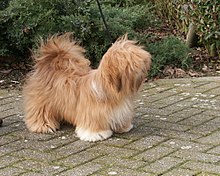 | ||||||||||||||||
| Origin | Tibet | |||||||||||||||
|---|---|---|---|---|---|---|---|---|---|---|---|---|---|---|---|---|
| ||||||||||||||||
| ||||||||||||||||
| Notes | FCI patronage: United Kingdom | |||||||||||||||
| Dog (domestic dog) | ||||||||||||||||
The Lhasa Apso (/ˈlɑːsə ˈæpsoʊ/ LAH-sə AP-soh) is a non-sporting dog breed originating in Tibet. Traditionally the breed has been used as an interior watchdog.
Etymology




Lhasa is the capital city of Tibet, and apso is a word from the Tibetan language. There is some debate over the exact origin of the name; some claim that the word "apso" is an anglicized form of the Tibetan word for goatee ("ag-tshom", ཨག་ཚོམ་) or perhaps "ra-pho" (ར་ཕོ་) meaning "billy goat". It may also be a compound noun meaning "bark-guard" (lit. "ap" , to bark, and "so" , to guard).
History
The Lhasa Apso is a thousand-year-old breed that historically served as sentinels at palaces and monasteries isolated high in the Himalayas of Tibet. In the early twentieth century some Tibetan dogs were brought to the United Kingdom by military men returning from the Indian subcontinent. These were of mixed types, similar either to what would become the Lhasa Apso or to what would become the Tibetan Terrier; they were collectively known as "Lhasa Terriers".
The first American pair of Lhasas were a gift from Thubten Gyatso, 13th Dalai Lama to C. Suydam Cutting, arriving in the United States in 1933. Mr. Cutting had traveled to Tibet and met the Dalai Lama. At the time, there was only one Lhasa Apso registered in England. The American Kennel Club officially accepted the breed in 1935 in the Terrier Group, and in 1959 transferred the breed to the Non-Sporting Group. In the UK, they are placed in the Utility Group.
The breed was definitively accepted by the Fédération Cynologique Internationale in 1960.
Characteristics
Dogs stand about 25 cm (9.8 in) at the withers, bitches slightly less. The coat may be black, red, dark grizzle, golden, honey, parti-colour, sandy, slate-coloured, smoke-coloured or white. It is thick and heavy, with a hard straight outer coat and a medium under-coat. The eyes are dark and the nose is black, and the ears are pendant. The tail is curved, sometimes with a kink at the tip, and should be carried over the back.
It ranks 68th (out of 138) in Stanley Coren's The Intelligence of Dogs, having fair working-obedience intelligence. The Lhasa Apso is a long-lived breed, with many living in good health into their early 20s.
Health

A 2024 UK study found a life expectancy of 14 years for the breed compared to an average of 12.7 for purebreeds and 12 for crossbreeds.
The breed is predisposed to atopic dermatitis.
References
- ^ FCI-Standard N° 227: Lhasa Apso. Fédération Cynologique Internationale. Accessed August 2021.
- ^ FCI breeds nomenclature: Lhasa Apso. Fédération Cynologique Internationale. Accessed August 2021.
- Definition of Lhasa apso, EtymologyOnline.com
- Wehrmann, Stephen (2002). Lhasa Apsos: Everything about Purchase, Care, Nutrition, Behavior, and Training. Barron's Educational Series. ISBN 0-7641-1958-3.
- Definition of "ab-pa", Rangjung Yeshe Tibetan Dictionary
- Definition of "so-ba", Rangjung Yeshe Tibetan Dictionary Archived 2020-01-01 at the Wayback Machine
- "Lhasa Apso Dog Breed Information". American Kennel Club. Retrieved 23 March 2023.
- Anne Rogers Clark, Andrew H. Brace (1995). The International Encyclopedia of Dogs. New York: Howell Book House. ISBN 0876056249.
- Wehrmann, Stephen (2002). Lhasa Apsos. Barrons Educational Service Publisher. ISBN 0-7641-1958-3.
- Aldige, Leslie (22 July 1968), "Dog of the Year", New York, pp. 32–34
- "Lhasa Apso History" Archived 2014-11-12 at the Wayback Machine, American Kennel Club
- "Dog intelligence rankings". 6abc.com. WPVI-TV. November 12, 2008. Archived from the original on December 18, 2010. Retrieved June 16, 2012.
- "Border Collie, Chinese Crested, English Mastiff, Italian Greyhound, Lhasa Apso". Dogs 101. Season 2. Episode 5. October 31, 2009. Event occurs at 3:01. Animal Planet. Retrieved January 27, 2013.
- McMillan, Kirsten M.; Bielby, Jon; Williams, Carys L.; Upjohn, Melissa M.; Casey, Rachel A.; Christley, Robert M. (2024-02-01). "Longevity of companion dog breeds: those at risk from early death". Scientific Reports. 14 (1). Springer Science and Business Media LLC. doi:10.1038/s41598-023-50458-w. ISSN 2045-2322. PMC 10834484.
- Rhodes, Karen Helton; Werner, Alexander H. (2011-01-25). Blackwell's Five-Minute Veterinary Consult Clinical Companion. Ames, Iowa: Wiley-Blackwell. p. 94. ISBN 978-0-8138-1596-1.
| Dogs originating in China and Taiwan | |
|---|---|
| China | |
| Tibet | |
| Taiwan | |